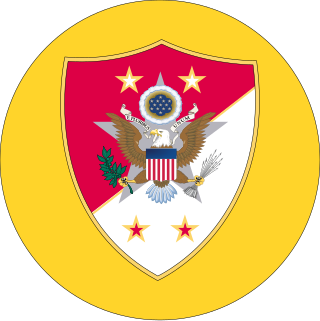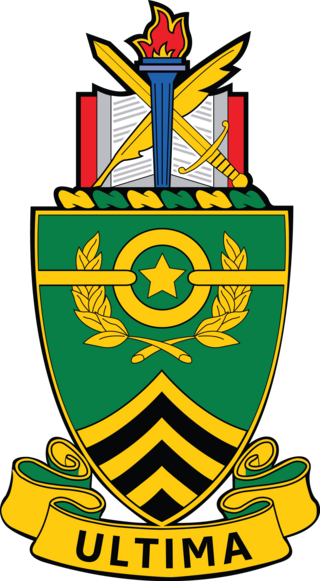
The Legion of Merit (LOM) is a military award of the United States Armed Forces that is given for exceptionally meritorious conduct in the performance of outstanding services and achievements. The decoration is issued to members of the eight uniformed services of the United States as well as to military and political figures of foreign governments.
A chief petty officer (CPO) is a senior non-commissioned officer in many navies and coast guards, usually above petty officer.
A master chief petty officer is a senior non-commissioned officer in many navies and coast guards, usually above some grade of petty officer.

The master chief petty officer of the Navy is a unique non-commissioned rank and position of office of the United States Navy, which is designated as a special paygrade above E-9. The holder of this position is the most senior enlisted member of the U.S. Navy, equivalent to the sergeant major of the Army, chief master sergeant of the Air Force, sergeant major of the Marine Corps, master chief petty officer of the Coast Guard, and chief master sergeant of the Space Force. The holder of this rank and position is the most senior enlisted sailor in the Navy, unless an enlisted sailor is serving as the senior enlisted advisor to the chairman. The current MCPON is James Honea.
A petty officer (PO) is a non-commissioned officer in many navies. Often they may be superior to a seaman, and subordinate to more senior non-commissioned officers, such as chief petty officers.

The sergeant major of the Army (SMA) is a unique noncommissioned rank and position of office in the United States Army. The holder of this rank and position is the most senior enlisted soldier in the Army, unless an enlisted soldier is serving as the senior enlisted advisor to the chairman. The SMA is appointed to serve as a spokesman to address the issues of enlisted soldiers to all officers, from warrant officers and lieutenants to the Army's highest positions. As such, they are the senior enlisted advisor to the chief of staff of the Army. The exact duties vary depending on the chief of staff, though much of the SMA's time is spent traveling throughout the Army, observing training and talking with soldiers and their families.

The Coast Guard Distinguished Service Medal (CGDSM) is a military decoration of the United States Coast Guard that was established 4 August 1949 and is presented to coast guardsmen for "Exceptionally meritorious service to the government in a duty of great responsibility." Prior to this date, members of the Coast Guard were eligible to receive the Navy Distinguished Service Medal. The Homeland Security Distinguished Service Medal, which replaced the Transportation Distinguished Service Medal in 2002, is another higher precedence Distinguished Service Medal that may be awarded to Coast Guardsmen. The Coast Guard Distinguished Service Medal is equivalent to the Army's Army Distinguished Service Medal, Naval Service's Navy Distinguished Service Medal, and the Air and Space Forces' Air Force Distinguished Service Medal.

Franklin A. Welch was the ninth Master Chief Petty Officer of the United States Coast Guard. Welch entered the Coast Guard in 1980 after graduating from Shades Valley High School Class of 1978, in Birmingham, Alabama. A former Master Chief Quartermaster, he served in office from October 10, 2002, to June 14, 2006, and served in the Coast Guard for over 26 years.

The United States Army Sergeants Major Academy (USASMA) was established on 1 July 1972 at Fort Bliss, Texas, and began instruction in January 1973. Its curriculum is designed to broaden the student's current knowledge base. This approach differs from the Military Occupational Specialty (MOS) related training at the basic and advanced levels of the Noncommissioned Officer Education System. The prime educational technique employed throughout the course is the small group participatory learning process.

In the United States Armed Forces, the ranks of warrant officer and chief warrant officer are rated as officers above all non-commissioned officers, candidates, cadets, and midshipmen, but subordinate to the lowest officer grade of O‑1. This application differs from the Commonwealth of Nations and other militaries, where warrant officers are the most senior of the other ranks, equivalent to the U.S. Armed Forces grades of E‑8 and E‑9.

Master Chief Aviation Electronics Technician Eric Anthony "Rick" Trent served as the seventh Master Chief Petty Officer of the Coast Guard from July 1, 1994, to May 31, 1998.

The senior enlisted advisor to the chairman of the Joint Chiefs of Staff (SEAC) is the most senior non-commissioned officer (NCO) position overall in the United States Armed Forces. The SEAC is appointed by the chairman of the Joint Chiefs of Staff to serve as a spokesperson to address the issues of enlisted personnel to the highest positions in the Department of Defense. As such, the SEAC is the primary enlisted advisor to the chairman, and serves at the pleasure of the secretary of defense. The SEAC's exact duties vary, depending on the chairman, though the SEAC generally devotes much of their time traveling throughout the Department of Defense, to observe training and communicating to service members and their families. The SEAC's normal term of assignment runs concurrently with the chairman, but an incumbent may be reappointed to serve longer. The first member to hold this post was William Gainey. The current SEAC is Troy E. Black, USMC who assumed the duties on 3 November 2023.
High Year Tenure (HYT) is a term used by the United States Armed Forces to describe the maximum number of years enlisted members may serve at a given rank without achieving promotion, after which they must separate or retire. HYT is applicable to enlisted personnel of all six military branches of the United States.

Anna Der-Vartanian was the first woman promoted to Master Chief Petty Officer (E-9), the highest enlisted rate in the United States Navy.
Chief petty officer (CPO) is the seventh enlisted rank in the United States Navy and U.S. Coast Guard, is above petty officer first class and below senior chief petty officer. The term "rating" is used to identify enlisted job specialties. In this way, enlisted personnel are segregated into three segments containing different enlisted ranks. Furthermore, rates are broken down into three levels: non-rated members without a designated occupation. Advancement to E-4 and above is dependent on graduating from a specialty school that define what the enlisted is rated for. Petty officers and chief petty officers are part of the rated force and considered extremely knowledgeable about their particular rating. Examples include Culinary Services Chief and Aviation Maintenance Chief. The Chief Petty Officer is the rank. Gunners Mate is a rating. E7 is a pay grade. The term rating is used to identify the career field of a chief petty officer. For example, the title of a chief petty officer in the Master-at-Arms rating would be spoken or spelled out as Chief Master-at-Arms. The title would be abbreviated MAC. The grade of chief petty officer was established on 1 April 1893 in the United States Navy. The United States Congress first authorized the Coast Guard to use the promotion to Chief Petty Officer on 18 May 1920. Chief petty officer is also the final cadet grade in the United States Naval Sea Cadet Corps.

An officer is a person who holds a position of authority as a member of an armed force or uniformed service.

Michael D. Stevens is a United States Navy sailor who served as Master Chief Petty Officer of the Navy (MCPON). He became the 13th MCPON on September 28, 2012, when he accepted the passing of the ceremonial cutlass from outgoing MCPON Rick D. West. He was succeeded by Steven S. Giordano on September 2, 2016.

Hollis Byron Stephens was the third Master Chief Petty Officer of the Coast Guard, serving as the enlisted advisor to the Commandant of the Coast Guard from 1977 to 1981. He was born in Georgia.













